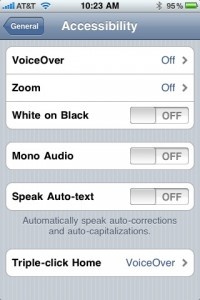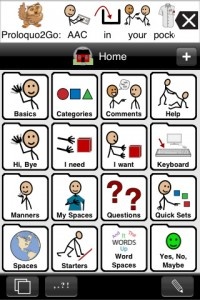
Until the release of the iPhone, iPod Touch, and iPad, users with physical, sensory, or cognitive disabilities relied on either dedicated devices or arcane, varying-quality software on PCs or Macs to get the support they needed to go about their daily lives in school, at work, or at home. Devices such as a Dynavox or even the popular Tango (developed by members of the XBox team) cost in the thousands of dollars and require intense training and practice to modify for individual users. Screen reading software for the blind, such as JAWS for Windows standard edition, can cost close to $1000 per license.
It's small wonder that students and individuals with disabilities relied on special education and other social services systems to provide funding for them to receive such software and hardware, with long wait lists the norm rather than the exception. School staff and families struggle to learn the devices and software, only to find them updated and changing with every new release.
With iOS, users with disabilities and the people that support them now have single device that can replace many of the forms and functions of dedicated devices, much less expensively and with less of a learning curve. With the standard user interface standardized hardware of iOS devices, developers can create assistive technology solutions faster and with less expense, allowing apps them to be customized to individuals with disabilities with less training needed.
The accessibility features built right into iOS are a boon to users with visual disabilities, allowing oft-neglected consumers the chance to participate in current, cutting edge technology right out of the box. VoiceOver puts device, preference and app screen navigation in the hands of folks with vision impairments, and is baked right into the OS itself. Not all apps take advantage of the VoiceOver system, but many do, like Apple's own iBooks e-book app.

Users who need a communication device now have an incredibly less expensive alternative - an iPad and ProLoQuo2Go, an app that's exorbitant by app store standards, but dirt cheep when compared to similar dedicated devices, like the above mentioned Tango and Dynavox. Proloquo2Go provides users a full featured communication system with over 7000 symbol/word pair items, solid text-to-speech functionality, and an extremely intuitive system for creating personalized communication boards on the iPad itself. Priced at well under $200, Proloquo2Go puts high-end augmentative communication devices within the reach of many more families and individuals than ever before, considering that a Dynavox with similar features costs well into the $6,500 range.

Speech recognition is another tool that was originally developed for the disability community and has since made many of our lives that much easier. Dragon Dictation is the iOS incarnation of the best of class speech recognition technology out there, and comes in at the cost of FREE. Users simply speak the words they want to write, and Dragon Dictation does the rest, allowing users to send the resulting text via email, SMS, or copy to the device clipboard for other use. For users with issues in small motor skill use, or shaky hands, this app (along with a host of others) is a must have app.
That any developer can create an app with as wide or as narrow an appeal as is needed, and then get that app to people who will use it, has created a whole new era for people with disabilities as well as those of us who do not have them, yet. Bringing people who have been traditionally left behind in our culture along with us into the new era of user-centric technology not only benefits the individual users of such tech, but our society as a whole. This lets us learn to see users with disabilities as people first, disabilities second.








